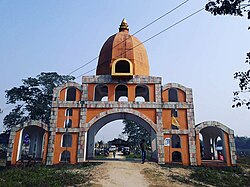Habung
Habung is a historical region in present-day Lakhimpur district of Assam, India, although some Tai-ahom activists claim it to be a part of present-day Dhemaji district.[1] According to Wade (1800), the region where the Subansiri river and the Brahmaputra rivers met was known as Habung.[2]As per epigrahic records, Habung (Ha-vrnga-Vishaya) was a Visaya or province where Brahmins were settled by Ratna Pala of the Pala dynasty of Kamarupa in the 10th century.[3]
HistoryEdit
Early historyEdit
The earliest reference to Habung comes in the 10th century copper plate grant of Ratnapala of the Pala dynasty, when it was a province (visaya) of the Kamarupa Kingdom with Brahmin settlements.[4][5]
It is known that Sukaphaa, the Ahom king, spent a few years in Habung before finally settling down at Charaideo in 1253.[6]
Chutia dynasty periodEdit
The oldest copperplates of land grants (found till date) made in this region are those by the Chutia kings, that date back to the year 1392 AD when king Satyanarayan donated 600 puti of land to a Brahman named Narayan Dwij at Dhenukhana.[7] This was the time when the Ahom prince Sudangphaa was still living with his Brahmin foster family at Habung.[8] The copper plate of Chutia king Dharmanarayan dated 1428 A.D. mentions Sri Vrihat-patra as Habung-aadhipati (lord of Habung). The plate records land grants of 400 puti given to a Brahmin named Purandar Vipra, indicating that Habung was a principality of the Chutia kingdom.[9]
Suhungmung, the Ahom king, following an expansionist policy and annexed Panbari of Habung in 1512 AD, which was a part of the Chutia kingdom.[10] The Chutia king Dhirnarayan attacked the Ahoms at Dikhoumukh the next year, but was unsuccessful. The Chutias again attacked the Ahoms in 1520 and occupied the areas up to Namdang and Mungkhrang.[11]
The last copperplate recording a grant made in the region was issued by king Dhirnarayan in 1522 A.D. at a place known as Konwargaon (present-day Dhakuakhana) after which the region was finally annexed by the Ahom king Suhungmung in 1523 A.D.[12]
Popular cultureEdit
The Habung region finds mention in several folk songs and tales. For instance, there is a Nisukoni geet(a form of lullaby) where the author talks about an old man(Habungia Burha) and a carpenter(Habungia Barhoi) from Habung.
"Haliki ei baper koloi gol,
Habungia burhar logot kah kubai gol.
.....
Habungia Barhoiye Charanao haje
Kurular keruhen uru uru kore,
Uribo nuwarihe sagarote pore."
NotesEdit
- ↑ Saikia (2004), p. 28:"Dhemaji is more political and therefore somewhat more volatile than Patsako. Tai-ahom activism was very visible there, so much so that the first capital city of the Ahom swargadeos, Habung, was identified and claimed to be in Dhemaji."
- ↑ Wade 1800, p. 16.
- ↑ "Habung was an ancient Brahmin settlement (Havrnga-Vishaya) situated near the mouth of the Dihing river." (Guha 1983:11) "According to tradition, Habung was a petty medieval principality governed by its Brahmin settlers themselves. It now appears from a recently found copper plate inscription that it was the same as the Ha-Vrnga Visaya where a Brahmin was given land by King Ratnapala. (c 10th century) (Guha 1983:33f)
- ↑ Habung was a Chutiya dependency; that still earlier it was an autonomous principality of Brahmins; and that the latter's origins could be traced back to a circa 10th-century copper-plate and grant issued by king Ratnapala (Guha 1984:73)
- ↑ The mention of Dibbaisa river forming southern boundary and Saica the south-western boundary led P.C. Choudhury to identify the Havranga visaya with Habung country lying to east of the river Suvansiri during the 10th-11th century A.D. Habung, comprising present Dhakuakhana region was for centuries a centre of Aryan culture
- ↑ Phukan 1992, p. 53.
- ↑ Baruah (2007), p. 38–39 : Two of these copperplates were issued by king Satyanarayan in 1314 saka (1392 AD)....This land was part of the Habung region where several Brahmin families had been settled.
- ↑ Baruah 1986, p. 225.
- ↑ Baruah 2007, p. 585.
- ↑ Baruah (2007), p. 128 : Suhungmung attacked Panbari, the western region of Habung province, situated on the North bank of Luit (Brahmaputra) in the year 1512. Habung was a part of Chutia kingdom...This is the reason why the Chutia king Dhirnarayan launched a naval as well as land attack against the Ahoms in the year 1513 at Dikhoumukh.
- ↑ Gait, Edward, "A History of Assam, p.84 The Chutias made no effort to regain their lost territory until 1520, when they attacked the Ahom fort at Mungkhrang. The Ahom commander was killed in a sortie and the garrison fled; and for a time the Chutias once more ruled this tract of country.
- ↑ Baruah 2007, p. 41–42.
ReferencesEdit
- Saikia, Yasmin (2004). Fragmented Memories: Struggling to be Tai-Ahom in India. Duke University Press. ISBN 9780822333739.
- Barua, Raj Sahib Golap Chandra (1930). Ahom Buranji (Reprinted ed.). Spectrum Publications , 1985. pp. 45–47.
- Acharyya, N.N (1987). A Brief History of Assam. Omsons Publications. pp. 71–73.
- Gogoi, Padmeswar (1968). The Tai and the Tai kingdoms: with a fuller treatment of the Tai-Ahom kingdom in the Brahmaputra Valley (First ed.). Dept. Of publication , Gauhati University. pp. 259–265.
- Guha, Amalendu (1983), "The Ahom Political System: An Enquiry into the State Formation Process in Medieval Assam (1228-1714)" (PDF), Social Scientist, 11 (12): 3–34, doi:10.2307/3516963, JSTOR 3516963
- Gait, Edward Albert (1906), A history of Assam, Calcutta, Thacker, Spink & co.
- Wade, John Peter (1800). An Account Of Assam. North Lakhimpur: R. SARMAH Madhupur Tea Estate.
- Baruah, Swarnalata (2007). Chutia Jatir Buranji.
- Phukan, J. N. (1992), "The Tai-Ahom Power in Assam", in Barpujari, H. K. (ed.), The Comprehensive History of Assam, vol. 2, Guwahati: Assam Publication Board, pp. 49–60
- Baruah, S L (1986), A Comprehensive History of Assam, Munshiram Manoharlal
